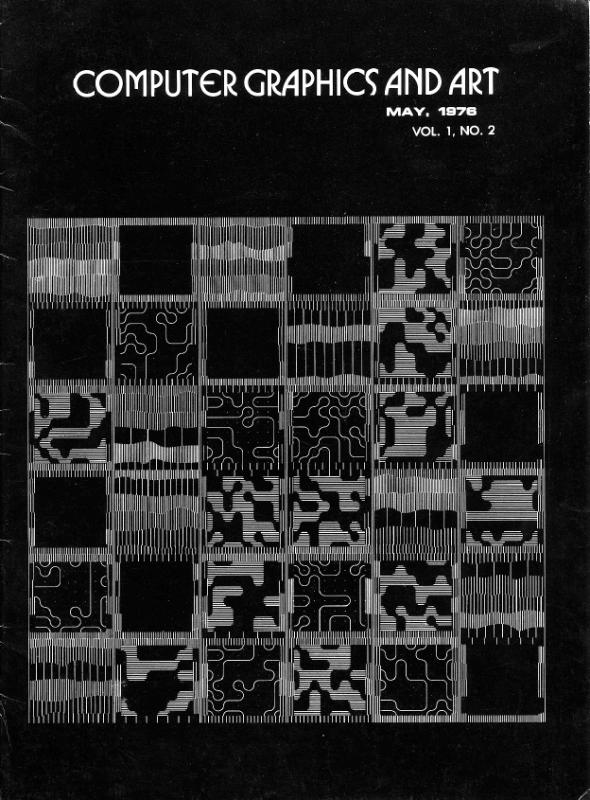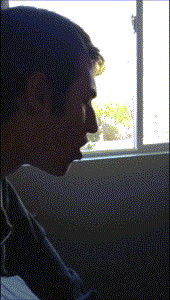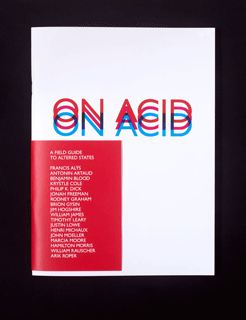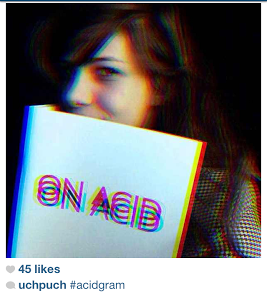9/29/12
9/28/12
9/26/12
Ayahuasqueros: A Trip on Nowness.com.
"Enchanting tribal songs lead Canadian anthropologist Jeremy Narby and French filmmaker and Soundwalk founder Stephan Crasneanscki through the psychedelic ayahuasca experience, in this clip from Ayahuasqueros: Recordings from the Amazon, Peru."
Crasneanscki: Ayahuasqueros was the idea of going up the river of the Amazon, deeper and deeper into the forest… I’m a newcomer. I arrived here because Radio France asked me to embark on a project about poetry—poetry in its active form, not a dead poetry. I thought that the icaros, the songs of the ayahuasca ceremony, were a form of poetry, a poetry that’s alive and has a function in society today.
Narby: An icaros is a melody that an ayahuasca shaman gets from his or her visions. In their visions these practitioners see what they consider to be the essence of living beings, of plants and animals, which is a melody. If you can learn that melody by singing along with it as you perceive it in your visions then you can see like these entities, and gain their knowledge and power. That’s what these icaros are: songs of knowledge and power. You judge the knowledge of a shaman by the number of number of icaros that he or she has, just like you judge a university professor by the number of books that he or she has published.
Crasneanscki: For me the icaros has something really special in the quality of the voices, the rhythm and rhyme. It’s all a cappella, there are no instruments. It’s extremely pure. It has a vibration, initially in the ear, that really takes you on a journey. Icaros is what you use to ride through the experience of Ayahuasca.
Narby: The melody works as a kind of lifeline that you can grab onto if you’re drowning in your visions. It’s true that these are songs of drunkenness and they are made to navigate drunkenness, so you can only fully appreciate their effect if you are yourself in that modified state of consciousness, and they are precisely tools for finding your way in that discombobulating space.
9/25/12
9/21/12
9/20/12
9/19/12
tripping on television
"HuffPost TV's supercut of TV drug use includes LSD trips to opium highs and much more in between from some of the most popular shows."
9/17/12
the acid archives
THE ACID ARCHIVES - SECOND EDITION
edited by Patrick Lundborg (Lysergia)
Underground albums from North America 1965-1982
The Psychedelic Review Archives 1963-1971

MAPS (Multidisciplinary Association for Psychedelic Studies) hosts the online archive for The Psychedelic Review, featuring complete PDFs of each issue.
a fundamental experiment

"I had in my possession some carbon tetrachloride, which I used to kill beetles for my collection. Knowing this substance belongs to the same chemical family as chloroform (it is even more toxic), I thought I could regulate its action very simply and easily: the moment I began to lose consciousness, my hand would fall form my nostrils carrying with it the handkerchief moistened with the volatile fluid. Later on I repeated the experiment in the presence of friends, who could have given me help had I needed it. The result was always exactly the same; that is, it exceeded and even overwhelmed my expectations by bursting the limits of the possible and by projecting me brutally into another world." - Rene Daumal, "A Fundamental Experiment"
published in Psychedelic Review, No. 5, 1965, p. 40 - 49 [PDF]
Labels:
Rene Daumal
9/16/12
psychedelic university
WORKING AT BAM CARUSO WAS LIKE ATTENDING PSYCHEDELIC UNIVERSITY.

"Apocalyptic bad trip blues of the finest hue, ‘Magic Potion’ sounds like one of the earliest (and best) stoner metal singles, up there with Blue Cheer. A Sabbath-heavy riff opens proceedings as singer Mike Brancaccio bangs on about the mind-opening properties of his magic potion. “All of a sudden there’s a different world appearing before my eyes… if you don’t want to try this potion, leave it all for me,” he says, greedily. I would have quite liked to have seen them at Happening 44 on Gerrard St in 1968."
FACT 20 BEST: UK PSYCH RECORDS EVER MADE by Richard Norris / The Time & Space Machine
9/15/12
psychic star map
"This book is a window on a poetic universe, a sort of psychic star map, a magnetic compass-card aligning itself and us with all manner of waves and currents. It is the work of a man who is looking for a path, the path, and finds it." - Antonin Artaud, Foreword to Black Mirror, Roger Gilbert-Lecomte.
Labels:
1934,
Antonin Artaud
experimental metaphysics
Excerpts from A Chronology of the Life of Roger Gilbert-Lecomte
1907 Roger Lecomte born on 18 May in Reims.
1921 First poems. With schoolmates starts a magazine, Apollo; is editor-in-chief.
1923 Lecomte, Daumal and others form a group, Les Simplistes; experiments with carbon tetrachloride.
1924 The Simplistes experiment with out-of-body experiences (carbon tetrachloride, ether, opium); discovery of Surrealism and automatic writing.
1925 Daumal begins studying Sanskrit; Lecomte develops first morphine habit, aided by a pharmacist's daughter.
1927 Experiments with extraretinal vision at Rene Maublanc's apartment; Lecomte attends medical school in Reims. Grand Jeu (Great Game) group is founded. The group name invented by Roger Vailland; weekly meeting chez Joseph Sima.
1928 Grand Jeu No. 1 (magazine) comes out in March.
1929 Surrealists sumon Grand Jeu group to meeting "to study possibilities of joint action" (March). Grand Jeu No. 2.
1930 Surrealists attempt to coopt Lecomte and Daumal; Daumal is publicly wooed by Breton; rebuffs Surrealist advances in an open letter to Breton. Lecomte is hospitalized in clinics for withdrawal from drugs several times this year. Daumal finishes Le Contre-ciel (Counter-heaven); starts relationship with Vera Milanova. Grand Jeu No. 3.
1931 Grand Jeu No. 4, its theme "experimental metaphysics," is ready for the printers but fails to comut out (It never did appear until the 1977 reprint of the whole of Grand Jeu magazine). Group beginning to disintegrate. Lecomte is detoxed several times.
1932 Grand Jeu group goes into final crisis; involvement in the "Aragon Affair." Fall: formal dissolution of Grand Jeu. December: Daumal leaves for New York City as press agent for Uday Shankar, the Hindu dancer. Lecomte delievers a lector at the Sorbonne, with Artaud in the audience: "The Metamorphoses of Poetry." Lecomte joins the Association of Revolutionary Artists and Writers, together with Breton, Crevel, et al.
1933 Death of Lecomte's mother. Lecomte arrested with a drug dealer; hospitalized. On leaving hospital he spends inheritance on drugs and an addict girlfriend. Publication of Lecomte's Life Love Death Void and Wind.
1935 Daumal's Counter-heaven wins the Jacques Doucet prize.
1937 Daumal's Night of Serious Drinking, a fictionalized account of Grand Jeu times, is published. Lecomte arrested for dealing drugs.
1938 Lecomte's Black Mirror is published.
1940 Lecomte's close friend Arthur Adamov, having tried unsuccessfully to persuade Lecomte to move to the Unoccupied Zone; Lecomte is found by Mme. Firmat unconscious in the street.
1941 Daumal translates Suzuki essays on Zen, a booklength collection to be published by Gallimard, guest-edits special issue of Cahiers du Sud on India; working on his own essays on Indian civilzation and Sanskrit literature and philsoophy to be published in France under the title Bharata (and in U.S. as Rasa).
1943 Daumal returns to Paris from a two-year convalescence in the Alps for TB; working on Mount Analogue. Lecomte, unattended at Broussais hospital, dies of tetanus. Although penniless at the moment, Lecomte was on the point of being awarded a large inheritance from a recently deceased aunt.
1944 Daumal dies in Paris of TB. Special issue of Cahiers du Sud dedicated to Lecomte.
1955 Publication of Testament, a volume of selected poems by Lecomte assembled by Arthur Adamov with the permission of Lecomte, Senior, by Gallimard.
9/12/12
9/11/12
roy orbison had a dream
One night Roy Orbison had a dream in which he heard a radio announcer say, "here's a new song from Elvis Presley." It was a very vivid dream and when Orbison woke up the next morning he remembered the song in perfect detail. Realizing the song was his and not Elvis's, he went to work and completed the composition in a matter of minutes. He called the song "In Dreams."
9/10/12
9/9/12
looking glass 06: alice in the city
Alice in den Staedten - Wim Wenders 1974
Out of the Blue - Dennis Hopper 1980
Christine F - Ulrich Edel 1981
Out of the Blue - Dennis Hopper 1980
Christine F - Ulrich Edel 1981
Subscribe to:
Posts (Atom)

















































